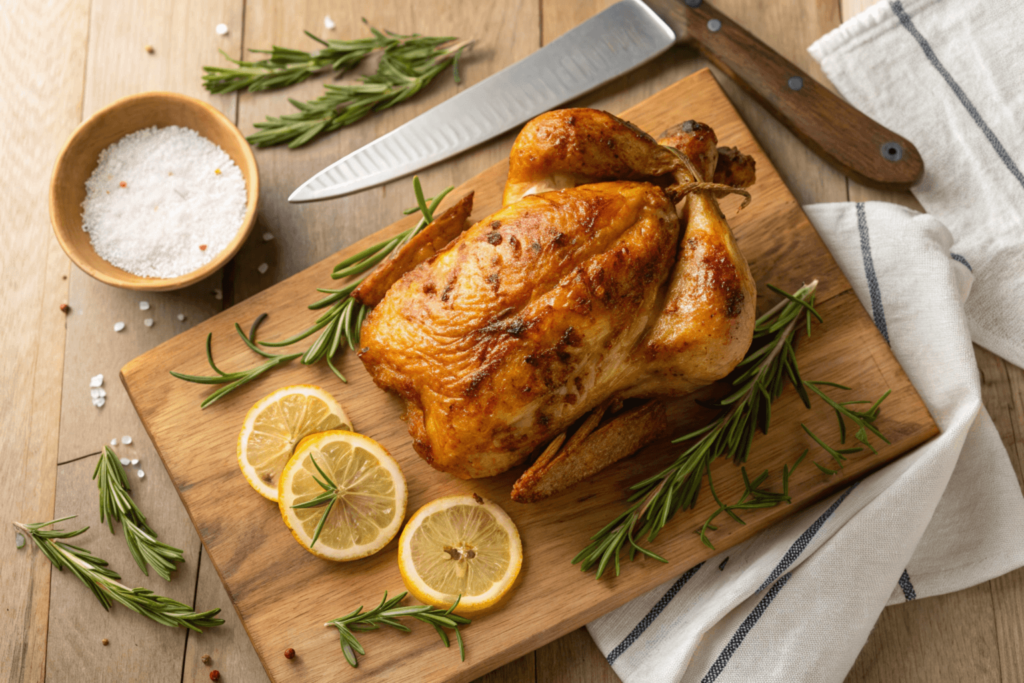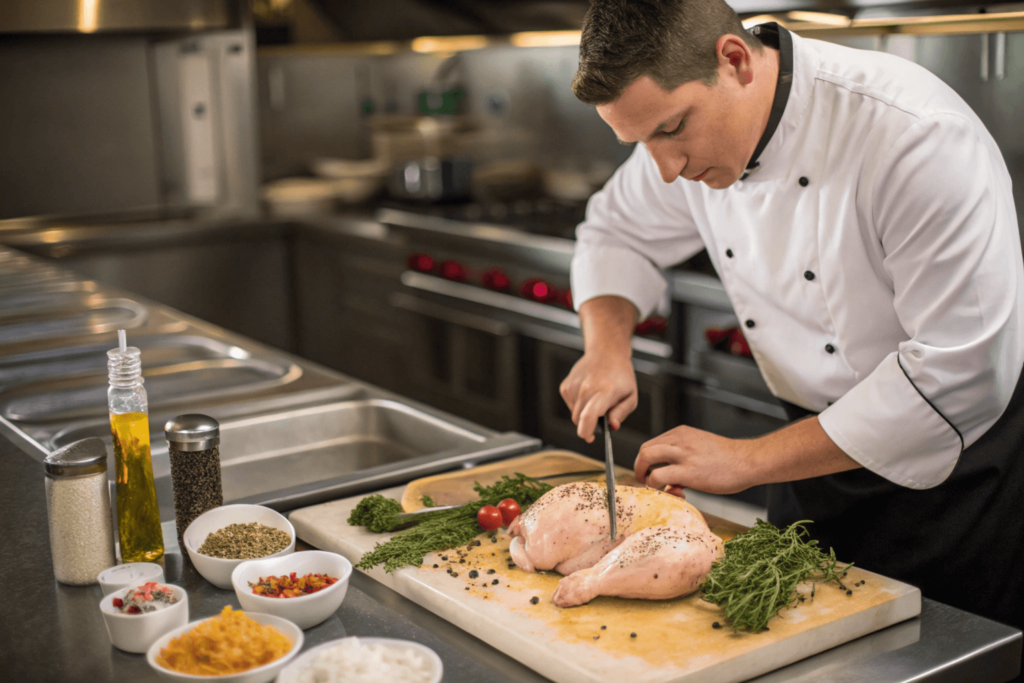
Introduction
Chicken is a staple in nearly every household, and for good reason. It’s versatile, affordable, and, when done right, absolutely delicious. But let’s be honest for a second—how many times have you tried to How to cook chicken like a chef and ended up with something dry, bland, or just plain boring?
If you’ve ever wondered why restaurant chicken tastes so much better than what you make at home, you’re not alone. The truth is, chefs don’t rely on magic—they simply use the right techniques, tools, and seasonings to make their chicken unforgettable. The best part? You don’t need a culinary degree to do the same. With a few insider tips, you’ll be whipping up chicken that rivals your favorite restaurants in no time.
So, tie on your apron, sharpen your knives, and let’s get started. By the end of this guide, you’ll know exactly how to cook chicken like a chef, right in your own kitchen.
Table of contents
- The Basics of Chicken Cooking like a chef?
- Essential Tools for Cooking Chicken
- Mastering Different Cooking Techniques like a chef?
- Seasoning Like a Pro
- Chef-Level Tips for Perfect Chicken
- Common Mistakes to Avoid
- Pairing Chicken with Sides and Sauces
- Recipes to Practice Your Skills
- Wrapping It Up: Cooking Chicken Like a Chef
- FAQs
The Basics of Chicken Cooking like a chef?
Choosing the Right Chicken
Cooking great chicken starts at the store. First, you’ve got to decide: fresh or frozen? Fresh chicken typically has better texture and flavor, but frozen works fine as long as you thaw it properly. (Pro tip: thaw frozen chicken in the fridge overnight—don’t leave it on the counter!)
Next, consider organic vs. conventional. Organic or free-range chicken tends to have a richer flavor and juicier texture because it’s raised differently. Sure, it’s pricier, but if flavor is your goal, it’s worth the splurge. Always check the sell-by date to make sure you’re buying the freshest chicken possible.
Prepping the Chicken
Once you’ve got your chicken, preparation is key. Start by trimming any excess fat or leftover bits of skin. If you’re working with a whole bird, remove any giblets from the cavity.
Rinse the chicken under cold water (or don’t, depending on your preference—some chefs argue this spreads bacteria). Whatever you choose, always pat the chicken dry with paper towels. Dry chicken = better sear.
Essential Tools for Cooking Chicken
Kitchen Equipment You’ll Need
You don’t need a fancy chef’s kitchen to cook great chicken, but a few tools will make your life a lot easier:
- Sharp knives: A good chef’s knife is essential for clean cuts and safe prep work.
- Cutting board: Choose a large, sturdy cutting board, ideally one that’s easy to clean.
- Cast-iron skillet: Perfect for searing and roasting, cast iron heats evenly and holds its temperature.
- Sheet pan: For roasting chicken breasts, thighs, or even a whole bird.
- Meat thermometer: Your secret weapon for perfectly cooked chicken every time.
Why You Need a Meat Thermometer
If there’s one tool every home cook should have, it’s a meat thermometer. Chicken can be tricky because it goes from undercooked to overcooked in minutes. A thermometer takes out the guesswork. Insert it into the thickest part of the meat—165°F is the magic number for perfectly cooked chicken.
Mastering Different Cooking Techniques like a chef?

Pan-Seared Perfection
Pan-searing is a chef’s go-to method for getting that beautiful, golden crust on chicken. Start with a hot skillet and a neutral oil like canola or grapeseed. Season your chicken with salt and pepper, then place it in the pan (skin side down if it has skin).
Here’s the key: resist the urge to move the chicken around! Let it sit for a good 5-7 minutes until it forms a crust. Flip it, cook for another 5-7 minutes, and finish in the oven if needed.
Roasting Like a Pro
Roasting is perfect for whole chickens or bone-in cuts. Preheat your oven to 425°F and season your chicken generously. If you’re roasting a whole bird, stuff the cavity with aromatics like lemon, garlic, and herbs for extra flavor.
Place the chicken on a roasting rack or a bed of veggies to ensure even cooking. For a crispy skin, baste the chicken with its juices or butter every 20 minutes.
Grilling Techniques
Grilling chicken can be tricky—it’s easy to overcook and dry out the meat. Start with medium heat and keep the grill lid closed to maintain an even temperature. Boneless cuts like breasts cook quickly, while thighs and drumsticks can handle a bit more time.
Always oil your grill grates to prevent sticking, and consider using a marinade or basting sauce to keep the meat juicy.
Braising for Tenderness
If you’ve never tried braising, you’re in for a treat. This slow-cooking method is ideal for tougher cuts like thighs or drumsticks. Start by browning the chicken in a heavy pot, then add a flavorful liquid—think chicken stock, wine, or even coconut milk.
Cover the pot and let the chicken simmer on low heat until it’s fork-tender. The result? Chicken so juicy and flavorful, it practically falls off the bone.
Seasoning Like a Pro
The Importance of Salt and Pepper
Let’s get one thing straight: seasoning isn’t optional. Salt enhances the natural flavor of chicken, while pepper adds a subtle kick. Season generously—it makes all the difference.
Marinades and Rubs
Marinades are a great way to infuse chicken with flavor. A classic marinade might include olive oil, lemon juice, garlic, and herbs. Let your chicken soak for at least 30 minutes, or up to 24 hours for maximum flavor.
Rub more your style? Try a dry spice mix. Paprika, garlic powder, onion powder, and cayenne are a winning combo.
Herbs and Spices
Fresh herbs like rosemary, thyme, and parsley take chicken to the next level. Don’t have fresh? No problem—dried herbs work too, just use a little less since they’re more concentrated.
Chef-Level Tips for Perfect Chicken
Letting the Chicken Rest
This might be the most overlooked step in home cooking. Resting allows the juices to redistribute throughout the meat, making it juicier. For smaller cuts, 5-10 minutes is enough. For a whole chicken, let it rest for 15-20 minutes before carving.
Slicing Against the Grain
When it’s time to carve or slice, always cut against the grain. This shortens the muscle fibers, making each bite more tender and easier to chew.
Common Mistakes to Avoid
Overcooking or Undercooking
Chicken is done at 165°F. Use your meat thermometer to check—don’t just rely on cooking times.
Not Resting the Meat
Cutting into chicken immediately after cooking is a rookie mistake. Resting locks in the juices, while skipping this step lets them spill out all over your cutting board.
Pairing Chicken with Sides and Sauces
Classic Side Dishes
You can’t go wrong with mashed potatoes, roasted veggies, or a fresh green salad. Want something different? Try cheesy polenta or garlic butter rice.
Simple Sauces
A good sauce can elevate your chicken to restaurant quality. Try a pan sauce made with chicken drippings, white wine, and butter. Or whip up a simple chimichurri for a fresh, zesty kick.
Recipes to Practice Your Skills
Pan-Seared Chicken Breast
- Season chicken breasts with salt, pepper, and paprika.
- Heat a skillet over medium-high heat and add a tablespoon of oil.
- Place the chicken in the skillet and cook for 5-7 minutes on each side.
- Check the temperature (165°F), then let it rest before slicing.
Perfect Roast Chicken
- Preheat oven to 425°F.
- Rub a whole chicken with olive oil, salt, and pepper. Stuff with lemon and herbs.
- Roast for 1-1.5 hours, basting every 20 minutes.
- Let it rest for 15 minutes before carving.
Wrapping It Up: Cooking Chicken Like a Chef
Cooking chicken like a chef doesn’t require a fancy kitchen or years of training—it just takes practice and a few insider tips. From mastering the art of seasoning to nailing the perfect sear, these techniques will transform your chicken game.
So the next time you’re in the kitchen, channel your inner chef. Trust me, your taste buds (and your dinner guests) will thank you.
FAQs
1. How do I keep chicken from drying out?
Use a meat thermometer to avoid overcooking, and always let the chicken rest before slicing.
2. Should I marinate chicken overnight?
You don’t have to, but longer marination adds more flavor. Even 30 minutes can make a big difference.
3. What’s the best temperature to cook chicken?
Chicken is safe to eat at 165°F, but letting dark meat go up to 175°F makes it extra tender.
4. Can I use the same techniques for other meats?
Absolutely! These methods work well for turkey, pork, and even fish, with slight adjustments.
5. How do I store leftover chicken?
Keep it in an airtight container in the fridge for up to 3 days. You can also freeze it for up to 3 months.
Conclusion
Learning how to cook chicken like a chef is a game-changer for any home cook. With the right tools, techniques, and a little patience, you can turn a simple piece of chicken into a masterpiece that rivals restaurant quality.
From choosing the right cut to mastering different cooking methods, you now have all the knowledge you need to step up your chicken game. Whether you’re grilling, roasting, or braising, remember to season generously, use a meat thermometer, and let your chicken rest before slicing. These small details make a big difference in flavor and texture.
So the next time you’re in the kitchen, don’t just cook chicken—own it. Treat it like the star of the meal, and you’ll create dishes that are as satisfying to make as they are to eat. Trust me, your family, friends, and even your taste buds will notice the difference.
Now it’s your turn to grab that chicken and make it something special. Bon appétit!
Final Thoughts
Cooking chicken like a chef isn’t just about fancy techniques or expensive tools. It’s about understanding the basics, choosing quality ingredients, and taking your time to get it right. From the crispy crust of a perfectly seared chicken breast to the juicy tenderness of a roasted whole bird, every method brings something special to the table.
One of the best things about chicken is its versatility—it can be dressed up or down, paired with almost any side dish, and seasoned in endless ways. Whether you’re hosting a dinner party or whipping up a quick weeknight meal, these chef-approved tips will help you make chicken that’s not only delicious but also impressive.
Remember, even professional chefs didn’t master these techniques overnight. The more you cook, the better you’ll get. So don’t be afraid to experiment, tweak recipes, and make mistakes—that’s how you learn. And most importantly, enjoy the process. Cooking should be fun, not stressful.
For more delicious recipes and culinary tips, explore the collection of recipes available on our website.
